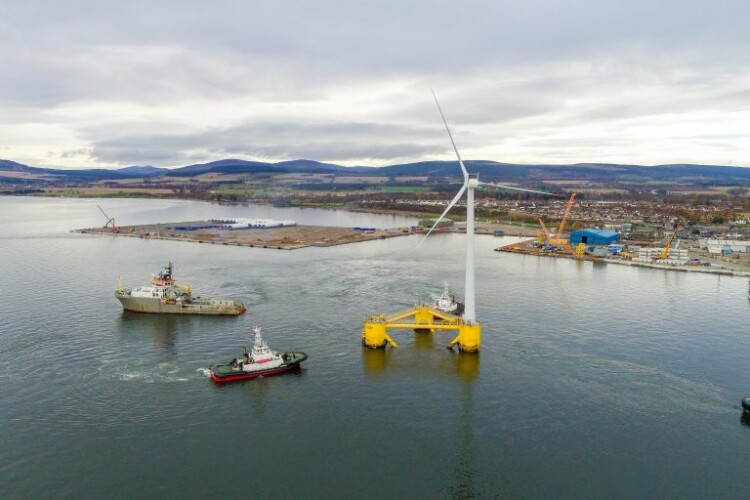The study examined the viability of a green hydrogen hub in the Cromarty Firth supplying distilleries in the region with hydrogen at a competitive price to help decarbonise their heating and processes in making whisky. The study was backed by partners including ScottishPower, Pale Blue Dot (a Storegga Group company), Port of Cromarty Firth and drinks giants Glenmorangie, Whyte & Mackay and Diageo.
The North of Scotland Hydrogen Programme ‘Distilleries Project’ study identified a number of sites around the Firth deemed fit to host a 35MW electrolyser facility by 2024. The facility would have a daily output of up to 14 tonnes of hydrogen, produced by green energy.
It could be further expanded to meet growing demand from across Scotland, the UK and internationally for green hydrogen. The zero-carbon fuel forms a key part of the Scottish government’s decarbonisation strategy and would contribute to the ambitions of becoming a leading hydrogen economy by 2030 and net-zero by 2045.
The report said the Cromarty Firth’s suitability was boosted by a large regional concentration of renewable energy potential, including future offshore wind development sites which would be able to supply the volume of clean electricity needed for the electrolyser.
Coupled with this substantial offshore wind resource stood an already significant existing infrastructure in the Cromarty Firth, as well as a track record in renewables, an experienced local supply chain and strong links to industry, transport and heat networks, it found.
The study said that green hydrogen has a role as a sustainable, safe, long-term energy solution for those who cannot decarbonise their operations through renewable electricity alone.
It proposes a phased development for the facility. Phase 1 would see the electrolyser in place by 2024 to meet local and distillery demands and to prove the technology at this scale. A second phase would lead to an expansion of green hydrogen to meet growing energy demands nationally and internationally.
Following the feasibility study success, the project will now move into its next stage of development which will include detailed engineering, community engagement and commercial development. This will prepare the project for a final investment decision, by 2023.
Bob Buskie, chief executive of the Port of Cromarty Firth, said: “This is fantastic news for both the Cromarty Firth and for the country’s ambitions to become a leading hydrogen nation, with targets for Scotland to generate 5GW of renewable and low-carbon hydrogen by 2030 – enough to power the equivalent of 1.8 million homes.

“Phase 1 of the electrolyser could be up and running, and the first hydrogen produced, by 2024 in what will be one of the biggest electrolysers in the UK. Such a facility will be a game changer not only for industries across the Highlands and Scotland, but also for the UK and internationally as we will be able to export green hydrogen to energy markets around the globe.”
Barry Carruthers, Hydrogen director at ScottishPower, said: “This is an industry-leading project, harnessing the region’s rich, renewable energy to help support industries and sectors near the Port of Cromarty Firth on their own decarbonisation journeys. The North of Scotland Hydrogen Programme will see the Highlands become home to one of the UK’s largest green hydrogen facilities and we’re looking forward to moving ahead with our partners, the Scottish government, Highland Council and all local stakeholders as we move into the next stages of the project.
“Now, more than ever, we need to see more projects like this being developed across the country. We’re in a climate emergency and so we have to focus on zero emission technologies – green hydrogen offers the long-term, sustainable, zero emission solution for industries, sectors and businesses that cannot be supported by renewable electricity alone. With only months to go until COP26, one of the most important climate summits, we’re showing what can be achieved when industry collaborates in order to tackle climate change.”
Nick Cooper, chief executive of Storegga, said: “This study confirms that the Cromarty Firth region is well positioned to play a leading role in Scotland’s green hydrogen economy. The consortium has jointly delivered a feasibility assessment that demonstrates the viability of the Phase 1 green hydrogen production plant. The plant will be developed in phases to become one of Europe’s largest hydrogen electrolysers.”
Dr Peter Nelson, operations director for the Glenmorangie Company, added: “We have all learnt a huge amount from the feasibility study into the potential of hydrogen as an alternative fuel source and excitingly for us it is firmly rooted in, and relevant to, the particular needs and challenges we all face in the North of Scotland.
It is a great example of collaboration across different companies and sectors and we look forward to progressing discussions further.”
Keith Miller, distillation & maturation director, Diageo, said “This was a great feasibility study to understand the potential of hydrogen in the Cromarty Firth area and we look forward to understanding the next steps.”
Shane Healy, director, production and distilling at Whyte & Mackay concluded: “Cromarty Firth is home to a thriving community and this project has been a catalyst to come together and share our vision for what the future of the local economy and community around it will be.”
Got a story? Email news@theconstructionindex.co.uk



